外研版(2019)选择性必修 第三册Unit5 Learning from nature Understanding ideas 课件(共40张PPT)
文档属性
| 名称 | 外研版(2019)选择性必修 第三册Unit5 Learning from nature Understanding ideas 课件(共40张PPT) | 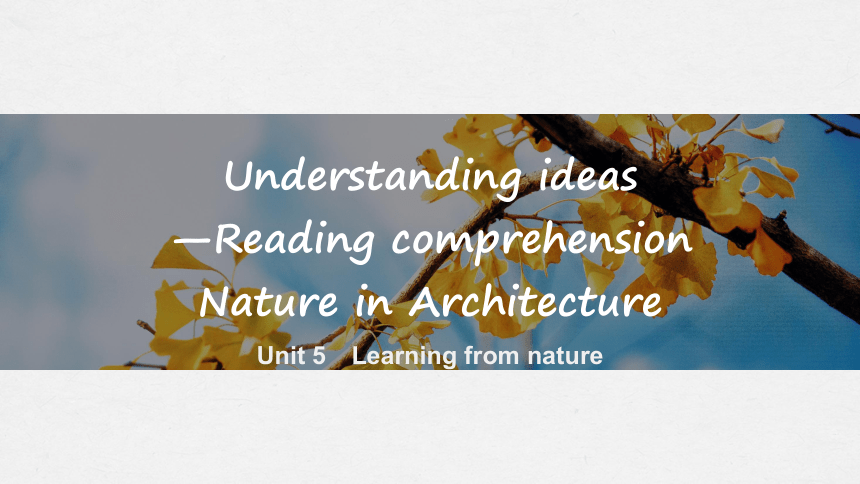 | |
| 格式 | pptx | ||
| 文件大小 | 33.0MB | ||
| 资源类型 | 教案 | ||
| 版本资源 | 外研版(2019) | ||
| 科目 | 英语 | ||
| 更新时间 | 2024-04-04 20:22:12 | ||
图片预览

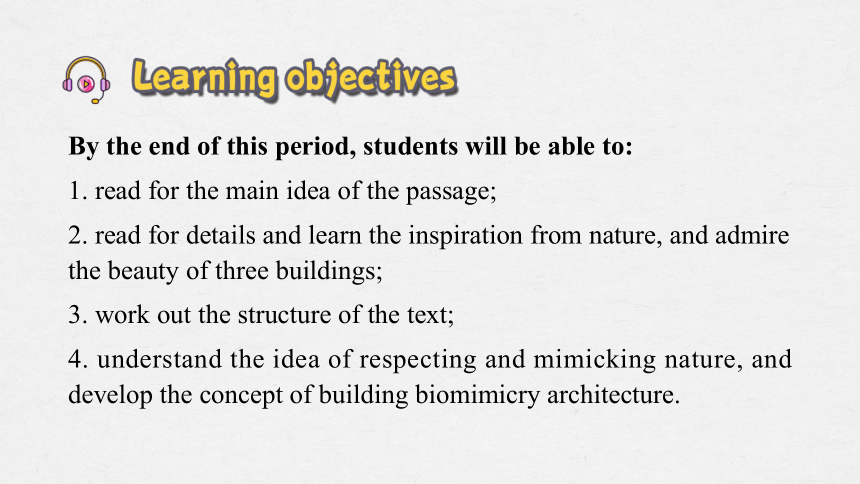
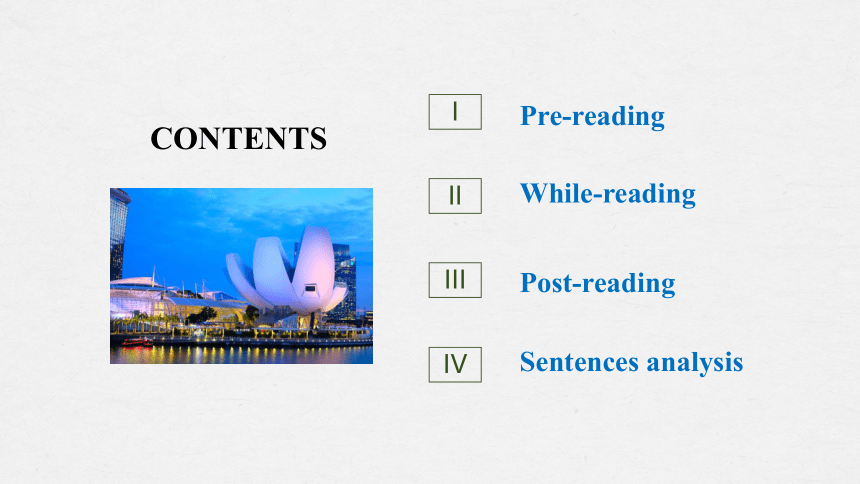
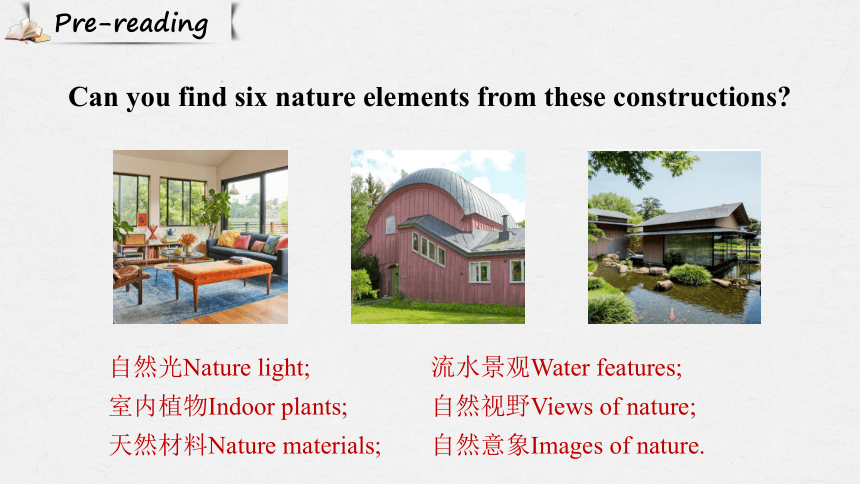
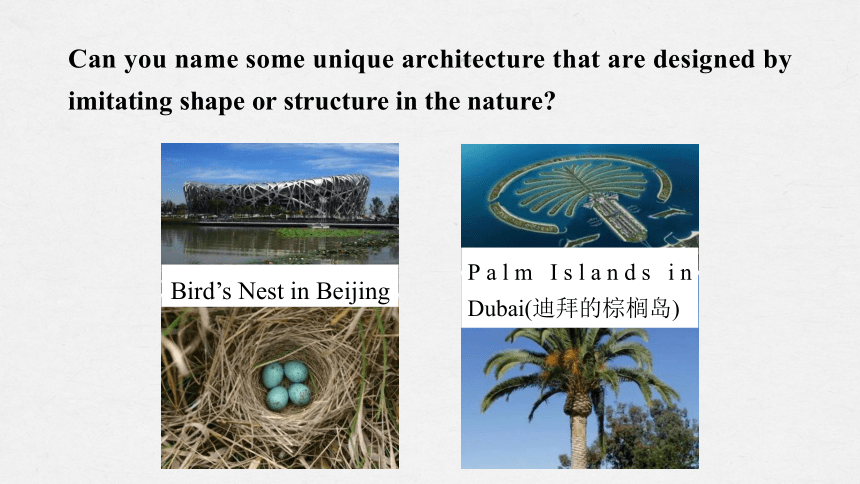
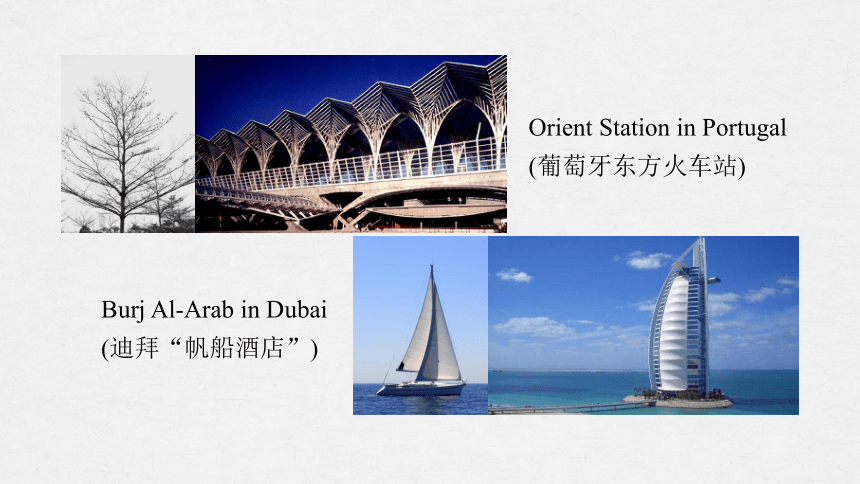

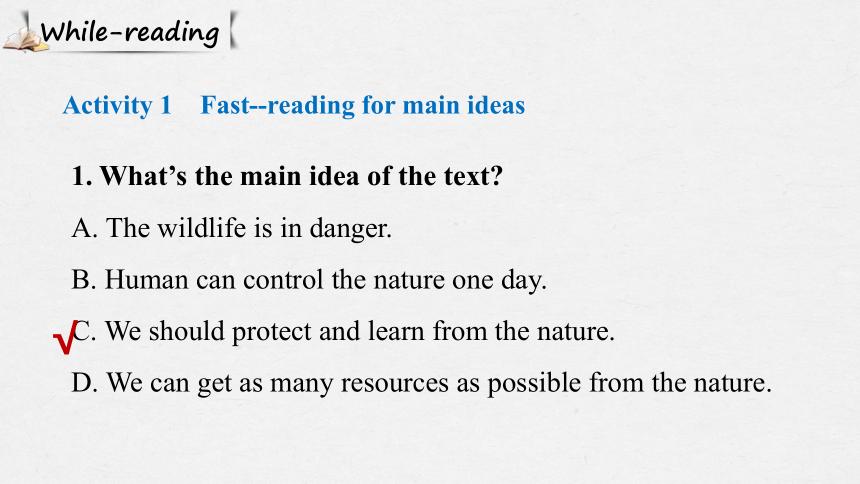
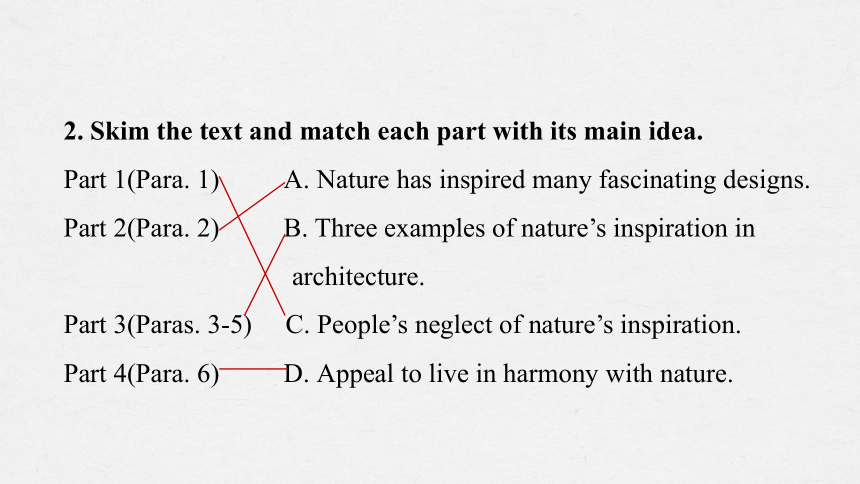
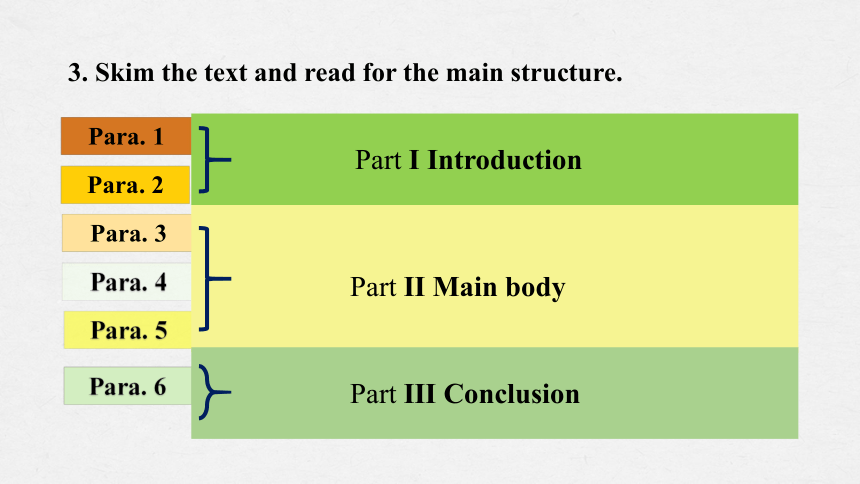
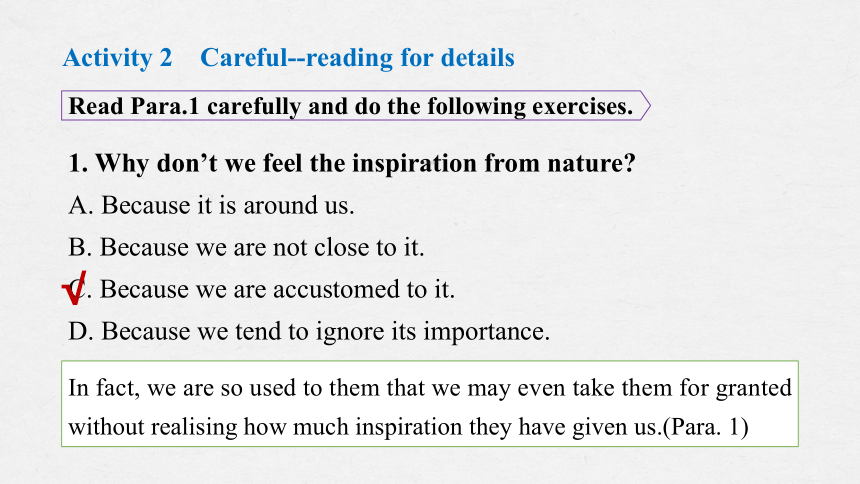
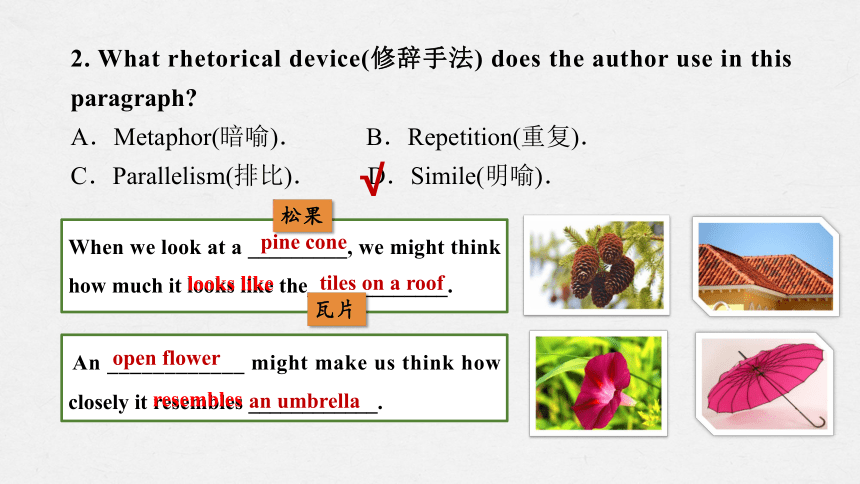
文档简介
(共40张PPT)
Understanding ideas
—Reading comprehension
Nature in Architecture
Unit 5 Learning from nature
By the end of this period, students will be able to:
1. read for the main idea of the passage;
2. read for details and learn the inspiration from nature, and admire the beauty of three buildings;
3. work out the structure of the text;
4. understand the idea of respecting and mimicking nature, and develop the concept of building biomimicry architecture.
CONTENTS
Pre-reading
I
While-reading
II
Post-reading
III
Sentences analysis
IV
Can you find six nature elements from these constructions
自然光Nature light; 流水景观Water features;
室内植物Indoor plants; 自然视野Views of nature;
天然材料Nature materials; 自然意象Images of nature.
Pre-reading
Can you name some unique architecture that are designed by imitating shape or structure in the nature
Bird’s Nest in Beijing
Palm Islands in Dubai(迪拜的棕榈岛)
Orient Station in Portugal
(葡萄牙东方火车站)
Burj Al-Arab in Dubai
(迪拜“帆船酒店”)
Look at the pictures and think about the questions.
1.What is shown in the pictures
2.How could you associate them with architecture
A lotus flower
A termite mound
Algae
Now read the passage and check your ideas.
1. What’s the main idea of the text
A. The wildlife is in danger.
B. Human can control the nature one day.
C. We should protect and learn from the nature.
D. We can get as many resources as possible from the nature.
While-reading
√
Activity 1 Fast- reading for main ideas
2. Skim the text and match each part with its main idea.
Part 1(Para. 1) A. Nature has inspired many fascinating designs.
Part 2(Para. 2) B. Three examples of nature’s inspiration in
architecture.
Part 3(Paras. 3-5) C. People’s neglect of nature’s inspiration.
Part 4(Para. 6) D. Appeal to live in harmony with nature.
Para. 1
Para. 3
Para. 4
Para. 5
Para. 6
Para. 2
Part Ⅰ Introduction
Part Ⅱ Main body
Part Ⅲ Conclusion
3. Skim the text and read for the main structure.
Activity 2 Careful- reading for details
In fact, we are so used to them that we may even take them for granted without realising how much inspiration they have given us.(Para. 1)
1. Why don’t we feel the inspiration from nature
A. Because it is around us.
B. Because we are not close to it.
C. Because we are accustomed to it.
D. Because we tend to ignore its importance.
√
Read Para.1 carefully and do the following exercises.
2. What rhetorical device(修辞手法) does the author use in this paragraph
A.Metaphor(暗喻). B.Repetition(重复).
C.Parallelism(排比). D.Simile(明喻).
√
When we look at a _________, we might think how much it looks like the_____________.
pine cone
tiles on a roof
瓦片
松果
An ____________ might make us think how closely it resembles ____________.
open flower
an umbrella
looks like
resembles
3. Try to find a phrase to show people’s attitude to nature.
Take them for granted.
In fact, we are so used to them that we may even take them for granted without realising how much inspiration they have given us.(Para. 1)
take…for granted 认为……理所当然
Nature has inspired many of the most fascinating designs around us, including those in architecture. From Barcelona’s (巴塞罗那) forest-like Sagrada Familia (圣家族大教堂) to the modern style of Beijing’s Water Cube, nature is presented in various architectural designs. Today, architects continue to explore ways to capture the beauty of natural forms, to mimic (模仿) the way nature works or even to make natural organisms part of a building.
1. What does the word “those” in the first sentence in Para. 2 refer to
The most fascinating designs.
2. How do architects present nature in various architectural designs
By capturing the beauty of natural forms;
by mimicking the way nature works;
by making natural organisms part of a building.
Read Para. 2 carefully and do the following exercise.
1. What’s the purpose of designing the ArtScience Museum
2. Fill in the blanks.
The building was designed to show the connection between nature and the modern city environment in which it sits.
To capture the beauty of natural forms
Shaped to resemble a ___________, the ArtScience Museum seems to float above the waterfront promenade and___________________________.
Its roof collects rainwater through the roof and _______________________ through its own plumbing system.
lotus flower
the water that surrounds it
the water is then recycled
Read Para. 3 carefully and do the following exercise.
Shaped to resemble a lotus flower, it appears to float above the waterfront promenade and the water that surrounds it.
3.What rhetorical device(修辞手法) does the author use in this sentence
A.Simile(明喻).
B.Personification(拟人).
C.Hyperbole(夸张).
D.Antithesis(对比).
√
1. What’s the design inspiration of The Eastgate Centre
Find the sentences in Para. 4.
2.Fill in the blanks.
To mimic the way nature works.
Based on the form and process of______________, Harare’s Eastgate Centre also has little holes in the walls to allow air to ________________________________, thus reducing the need for _________________________________________.
In this way, it uses ___________ and costs less to run.
termite mounds
move freely in and out of the mounds
traditional air conditioning and heating systems
less energy
Zimbabwean architect Mick Pearce was inspired to create the Centre while watching a nature documentary in which termites(白蚁) were constructing their nests.
Read Para. 4 carefully and do the following exercise.
3. Why does the author mention the documentary
A. To illustrate termites are very smart.
B. To show Mick Pearce is very smart.
C. To show termites’ nests are sustainable.
D. To state the source of Mick Pearce’s idea.
√
Bionic Architecture
仿生建筑
Bionic architecture is inspired by nature, influencing designs that maintain ecological balance(生态平衡) and meet sustainability (可持续) factors.
Bionic architecture is a movement which searches for more balance with the natural earth.
Background information
1. What’s unique about the Algae House
A. It can protect the environment.
B. It can produce its own renewable energy.
C. Its solar panels capture heat from the sun.
D. It provides shade for people.
√
2.Fill in the blanks.
To ____________________________________, the Algae House is covered in panels containing algae. While the panels provide shade, _______________________ and convert it into energy, the algae can also be used to ____________.The building reduces damage to the environment by ________________________________.
make natural organisms part of a building
capture heat from the sun
produce fuel
generating its own renewable energy
Read Para. 5 carefully and do the following exercise.
The panels also capture heat from the sun and convert it into energy that powers the building. And that’s not all—the algae inside the panels can be harvested and used to produce fuel.
How does the building generate its own renewable energy
3.What’s the similarity between the Eastgate Centre and the Algae House
A. Having panels providing energy for the building.
B. Having a skin covered in holes.
C. Being examples of biomimicry.
D. Using less energy.
√
They are all environmentally friendly.
Creating buildings such as these enables us to live in closer harmony with our environment. To meet the needs of today while protecting the world of tomorrow may be a challenge, but even the simplest organisms can help teach us how to achieve this.
What can we conclude from this paragraph
Nature-inspired buildings enable us to live in closer harmony with our environment.
Read Para. 6 carefully and do the following exercise.
1. What is the structure of the text
√
Read the whole passage again and do the following exercises.
2. What type of text is this passage
A.Narration(记叙文).
B.Argumentation(议论文).
C.Exposition(说明文).
D.News report(新闻报道).
√
3. How does the passage mainly develop
A.By listing numbers.
B.By following the order of time.
C.By making a comparison.
D.By giving examples.
√
4. In which magazine would you most likely find the passage
A.Extraordinary Architects.
B.Living on Earth.
C.Architecture Frontier.
D.Natural World.
√
5.What can we conclude from the text
A.Nature is influenced by human architecture.
B.Nature is full of mysteries.
C.Nature can be our teacher.
D.Humans should protect nature.
√
Post-reading
1. What can you learn from this passage (Critical thinking)
Nature-inspired architectural designs are sustainable techniques in design. Methods like the use of solar panels, rain-water harvesting systems, natural heating and cooling systems, garbage, and sewage treatment systems, provide necessary resources to the users of the structure and also reduce the impact on the environment on a larger scale. It also creates awareness within the users of their responsibility towards nature. Nature-inspired friendly designs are a big challenge, which needs our joint efforts.
Activity 1 Discussion
2. If you were given a chance to design a building, what inspiration would you take from nature (Creative thinking)
You can answer the question from the following aspects:
Where your inspiration comes from.
How you connect nature with your design.
How your design works.
How your design benefits the environment.
The significance of nature in architecture
To meet the needs of today while protecting the world of tomorrow would be necessary. So Bionic architecture will lead the trend of the architecture. Nature-inspired, biomimetic and friendly-environment architecture benefits our physical and mental health, enabling us to live in closer harmony with our environment.
There is much 1.__________(inspire) from nature in our daily lives, and nature has also inspired many of the 2._______________(fascinating) designs around us. Shaped to resemble 3.____ a lotus flower, the ArtScience Museum seems to float above the waterfront promenade and the water 4.___________surrounds it. It collects rainwater through the roof and channels it 35 metres down to a waterfall, and then the water is recycled through the plumbing system.5._______(base) on the form and process of termites’ building mounds, Harare’s Eastgate Centre also has little holes on the walls allowing air to move 6.________(free) in and out, thus 7.__________(reduce) the need for traditional air conditioning and heating systems. In this way, it uses less energy and costs less to run. However, the Algae House 8.___________(cover) in panels containing algae. While the panels provide shade, they also capture heat from the sun and convert it into energy, 9.______ the algae can also be used 10.___________(produce) fuel. The building reduces damage to the environment by generating its own renewable energy.
Activity 2 Summary
inspiration
a
most fascinating
that/which
Based
freely
reducing
is covered
and
to produce
Sentences Analysis
1. In fact, we are so used to them that we may even take them for granted without realising how much inspiration they have given us.
[句式分析] 该句为是_____句。主句为so...that...结构,that引导__________从句;take...for granted意为“_________________”,how much inspiration they have given us引导的为_______从句。
[自主翻译]
复合
宾语
事实上,我们已经习惯了它们的存在,甚至可能把它们
结果状语
认为……理所当然
视为理所当然,却没有意识到它们给了我们多少灵感。
2. It is natural to think in this way, but of course it wasn’t the umbrella that inspired the flower or the roof that inspired the pine cone.
[句式分析] 该句是but连接的_____句。It是形式主语,真正的主语为________;but后的分句含有_____________,其基本结构为
___________________________________________。
[自主翻译]
并列
It is / was + 被强调的部分 + that + 其他部分
以这种方式思考是很自然的,但当然不是雨伞给了
强调句式
花朵灵感,也不是屋顶给了松果灵感。
3.Today, architects continue to explore ways to capture the beauty of natural forms, to mimic the way nature works or even to make natural organisms part of a building.
[句式分析] 此句是________句。主句中主语为____________;continue为____________;to explore ways...为不定式短语作_______;nature works是_______从句,修饰the way;定语从句中省略了关系词__________或者______;make natural organisms part of a building是“_____________________”结构。
[自主翻译]
复合
architects
谓语动词
宾语
如今,建筑师不断探寻捕捉自然形态之美的方法,
定语
make+宾语+宾补
in which
that
模仿自然运行的方式,或者让自然生物融为建筑的一部分。
4. People whose interest is exploring the relationship between art and science will enjoy Singapore’s ArtScience Museum.
[句式分析] 此句为________句。主语和谓语为________和____________;whose引导的为__________从句,修饰__________。
[自主翻译]
复合
will enjoy
定语
对探索艺术与科学的关系感兴趣的人会乐于参观新加坡
People
People
的艺术科学博物馆。
5. Zimbabwean architect Mick Pearce was inspired to create the Centre while watching a nature documentary in which termites were constructing their nests.
[句式分析] 此句是______句。while watching a nature documentary是__________从句的省略,完整形式为_______________________________________;in which引导_____ 从句,修饰documentary。
[自主翻译]
复合
定语
while he was watching a nature documentary
津巴布韦建筑师米克·皮尔斯在一部大自然纪录片中
时间状语
看到白蚁筑造蚁穴,从中得到启发,从而设计了东门大厦。
6. The insects built mounds covered in little holes designed to allow air to move freely in and out of the mounds.
[句式分析] 此句是_________句。此句主干为:_____,为_________结构,句中含有两个过去分词短语;第一个为covered in little holes,作_________,修饰前面名词_______;第二个为designed to allow air to move......作_________,修饰前面的名词_______;过去分词作后置定语,相当于一个________从句。
[自主翻译]
主谓宾
后置定语
后置定语
mounds
这种昆虫搭建表面覆有小洞的蚁丘,以保证蚁丘内外
holes
定语
简单
部的空气流通。
7.To meet the needs of today while protecting the world of tomorrow
may be a challenge, but even the simplest organisms can help teach us
how to achieve this.
[句式分析] 该句是but连接的______句。but前的分句中为_____________作主语,while protecting......为“连词+现在分词”作__________;how to achieve this为______从句。
[自主翻译]
并列
宾语
动词不定式
保护明天的世界,同时满足当下的需求,这可能是一项
时间状语
挑战,但即使是最简单的生物也能帮忙,教我们如何实现目标。
Homework
Review what we have learnt and preview language points.
Understanding ideas
—Reading comprehension
Nature in Architecture
Unit 5 Learning from nature
By the end of this period, students will be able to:
1. read for the main idea of the passage;
2. read for details and learn the inspiration from nature, and admire the beauty of three buildings;
3. work out the structure of the text;
4. understand the idea of respecting and mimicking nature, and develop the concept of building biomimicry architecture.
CONTENTS
Pre-reading
I
While-reading
II
Post-reading
III
Sentences analysis
IV
Can you find six nature elements from these constructions
自然光Nature light; 流水景观Water features;
室内植物Indoor plants; 自然视野Views of nature;
天然材料Nature materials; 自然意象Images of nature.
Pre-reading
Can you name some unique architecture that are designed by imitating shape or structure in the nature
Bird’s Nest in Beijing
Palm Islands in Dubai(迪拜的棕榈岛)
Orient Station in Portugal
(葡萄牙东方火车站)
Burj Al-Arab in Dubai
(迪拜“帆船酒店”)
Look at the pictures and think about the questions.
1.What is shown in the pictures
2.How could you associate them with architecture
A lotus flower
A termite mound
Algae
Now read the passage and check your ideas.
1. What’s the main idea of the text
A. The wildlife is in danger.
B. Human can control the nature one day.
C. We should protect and learn from the nature.
D. We can get as many resources as possible from the nature.
While-reading
√
Activity 1 Fast- reading for main ideas
2. Skim the text and match each part with its main idea.
Part 1(Para. 1) A. Nature has inspired many fascinating designs.
Part 2(Para. 2) B. Three examples of nature’s inspiration in
architecture.
Part 3(Paras. 3-5) C. People’s neglect of nature’s inspiration.
Part 4(Para. 6) D. Appeal to live in harmony with nature.
Para. 1
Para. 3
Para. 4
Para. 5
Para. 6
Para. 2
Part Ⅰ Introduction
Part Ⅱ Main body
Part Ⅲ Conclusion
3. Skim the text and read for the main structure.
Activity 2 Careful- reading for details
In fact, we are so used to them that we may even take them for granted without realising how much inspiration they have given us.(Para. 1)
1. Why don’t we feel the inspiration from nature
A. Because it is around us.
B. Because we are not close to it.
C. Because we are accustomed to it.
D. Because we tend to ignore its importance.
√
Read Para.1 carefully and do the following exercises.
2. What rhetorical device(修辞手法) does the author use in this paragraph
A.Metaphor(暗喻). B.Repetition(重复).
C.Parallelism(排比). D.Simile(明喻).
√
When we look at a _________, we might think how much it looks like the_____________.
pine cone
tiles on a roof
瓦片
松果
An ____________ might make us think how closely it resembles ____________.
open flower
an umbrella
looks like
resembles
3. Try to find a phrase to show people’s attitude to nature.
Take them for granted.
In fact, we are so used to them that we may even take them for granted without realising how much inspiration they have given us.(Para. 1)
take…for granted 认为……理所当然
Nature has inspired many of the most fascinating designs around us, including those in architecture. From Barcelona’s (巴塞罗那) forest-like Sagrada Familia (圣家族大教堂) to the modern style of Beijing’s Water Cube, nature is presented in various architectural designs. Today, architects continue to explore ways to capture the beauty of natural forms, to mimic (模仿) the way nature works or even to make natural organisms part of a building.
1. What does the word “those” in the first sentence in Para. 2 refer to
The most fascinating designs.
2. How do architects present nature in various architectural designs
By capturing the beauty of natural forms;
by mimicking the way nature works;
by making natural organisms part of a building.
Read Para. 2 carefully and do the following exercise.
1. What’s the purpose of designing the ArtScience Museum
2. Fill in the blanks.
The building was designed to show the connection between nature and the modern city environment in which it sits.
To capture the beauty of natural forms
Shaped to resemble a ___________, the ArtScience Museum seems to float above the waterfront promenade and___________________________.
Its roof collects rainwater through the roof and _______________________ through its own plumbing system.
lotus flower
the water that surrounds it
the water is then recycled
Read Para. 3 carefully and do the following exercise.
Shaped to resemble a lotus flower, it appears to float above the waterfront promenade and the water that surrounds it.
3.What rhetorical device(修辞手法) does the author use in this sentence
A.Simile(明喻).
B.Personification(拟人).
C.Hyperbole(夸张).
D.Antithesis(对比).
√
1. What’s the design inspiration of The Eastgate Centre
Find the sentences in Para. 4.
2.Fill in the blanks.
To mimic the way nature works.
Based on the form and process of______________, Harare’s Eastgate Centre also has little holes in the walls to allow air to ________________________________, thus reducing the need for _________________________________________.
In this way, it uses ___________ and costs less to run.
termite mounds
move freely in and out of the mounds
traditional air conditioning and heating systems
less energy
Zimbabwean architect Mick Pearce was inspired to create the Centre while watching a nature documentary in which termites(白蚁) were constructing their nests.
Read Para. 4 carefully and do the following exercise.
3. Why does the author mention the documentary
A. To illustrate termites are very smart.
B. To show Mick Pearce is very smart.
C. To show termites’ nests are sustainable.
D. To state the source of Mick Pearce’s idea.
√
Bionic Architecture
仿生建筑
Bionic architecture is inspired by nature, influencing designs that maintain ecological balance(生态平衡) and meet sustainability (可持续) factors.
Bionic architecture is a movement which searches for more balance with the natural earth.
Background information
1. What’s unique about the Algae House
A. It can protect the environment.
B. It can produce its own renewable energy.
C. Its solar panels capture heat from the sun.
D. It provides shade for people.
√
2.Fill in the blanks.
To ____________________________________, the Algae House is covered in panels containing algae. While the panels provide shade, _______________________ and convert it into energy, the algae can also be used to ____________.The building reduces damage to the environment by ________________________________.
make natural organisms part of a building
capture heat from the sun
produce fuel
generating its own renewable energy
Read Para. 5 carefully and do the following exercise.
The panels also capture heat from the sun and convert it into energy that powers the building. And that’s not all—the algae inside the panels can be harvested and used to produce fuel.
How does the building generate its own renewable energy
3.What’s the similarity between the Eastgate Centre and the Algae House
A. Having panels providing energy for the building.
B. Having a skin covered in holes.
C. Being examples of biomimicry.
D. Using less energy.
√
They are all environmentally friendly.
Creating buildings such as these enables us to live in closer harmony with our environment. To meet the needs of today while protecting the world of tomorrow may be a challenge, but even the simplest organisms can help teach us how to achieve this.
What can we conclude from this paragraph
Nature-inspired buildings enable us to live in closer harmony with our environment.
Read Para. 6 carefully and do the following exercise.
1. What is the structure of the text
√
Read the whole passage again and do the following exercises.
2. What type of text is this passage
A.Narration(记叙文).
B.Argumentation(议论文).
C.Exposition(说明文).
D.News report(新闻报道).
√
3. How does the passage mainly develop
A.By listing numbers.
B.By following the order of time.
C.By making a comparison.
D.By giving examples.
√
4. In which magazine would you most likely find the passage
A.Extraordinary Architects.
B.Living on Earth.
C.Architecture Frontier.
D.Natural World.
√
5.What can we conclude from the text
A.Nature is influenced by human architecture.
B.Nature is full of mysteries.
C.Nature can be our teacher.
D.Humans should protect nature.
√
Post-reading
1. What can you learn from this passage (Critical thinking)
Nature-inspired architectural designs are sustainable techniques in design. Methods like the use of solar panels, rain-water harvesting systems, natural heating and cooling systems, garbage, and sewage treatment systems, provide necessary resources to the users of the structure and also reduce the impact on the environment on a larger scale. It also creates awareness within the users of their responsibility towards nature. Nature-inspired friendly designs are a big challenge, which needs our joint efforts.
Activity 1 Discussion
2. If you were given a chance to design a building, what inspiration would you take from nature (Creative thinking)
You can answer the question from the following aspects:
Where your inspiration comes from.
How you connect nature with your design.
How your design works.
How your design benefits the environment.
The significance of nature in architecture
To meet the needs of today while protecting the world of tomorrow would be necessary. So Bionic architecture will lead the trend of the architecture. Nature-inspired, biomimetic and friendly-environment architecture benefits our physical and mental health, enabling us to live in closer harmony with our environment.
There is much 1.__________(inspire) from nature in our daily lives, and nature has also inspired many of the 2._______________(fascinating) designs around us. Shaped to resemble 3.____ a lotus flower, the ArtScience Museum seems to float above the waterfront promenade and the water 4.___________surrounds it. It collects rainwater through the roof and channels it 35 metres down to a waterfall, and then the water is recycled through the plumbing system.5._______(base) on the form and process of termites’ building mounds, Harare’s Eastgate Centre also has little holes on the walls allowing air to move 6.________(free) in and out, thus 7.__________(reduce) the need for traditional air conditioning and heating systems. In this way, it uses less energy and costs less to run. However, the Algae House 8.___________(cover) in panels containing algae. While the panels provide shade, they also capture heat from the sun and convert it into energy, 9.______ the algae can also be used 10.___________(produce) fuel. The building reduces damage to the environment by generating its own renewable energy.
Activity 2 Summary
inspiration
a
most fascinating
that/which
Based
freely
reducing
is covered
and
to produce
Sentences Analysis
1. In fact, we are so used to them that we may even take them for granted without realising how much inspiration they have given us.
[句式分析] 该句为是_____句。主句为so...that...结构,that引导__________从句;take...for granted意为“_________________”,how much inspiration they have given us引导的为_______从句。
[自主翻译]
复合
宾语
事实上,我们已经习惯了它们的存在,甚至可能把它们
结果状语
认为……理所当然
视为理所当然,却没有意识到它们给了我们多少灵感。
2. It is natural to think in this way, but of course it wasn’t the umbrella that inspired the flower or the roof that inspired the pine cone.
[句式分析] 该句是but连接的_____句。It是形式主语,真正的主语为________;but后的分句含有_____________,其基本结构为
___________________________________________。
[自主翻译]
并列
It is / was + 被强调的部分 + that + 其他部分
以这种方式思考是很自然的,但当然不是雨伞给了
强调句式
花朵灵感,也不是屋顶给了松果灵感。
3.Today, architects continue to explore ways to capture the beauty of natural forms, to mimic the way nature works or even to make natural organisms part of a building.
[句式分析] 此句是________句。主句中主语为____________;continue为____________;to explore ways...为不定式短语作_______;nature works是_______从句,修饰the way;定语从句中省略了关系词__________或者______;make natural organisms part of a building是“_____________________”结构。
[自主翻译]
复合
architects
谓语动词
宾语
如今,建筑师不断探寻捕捉自然形态之美的方法,
定语
make+宾语+宾补
in which
that
模仿自然运行的方式,或者让自然生物融为建筑的一部分。
4. People whose interest is exploring the relationship between art and science will enjoy Singapore’s ArtScience Museum.
[句式分析] 此句为________句。主语和谓语为________和____________;whose引导的为__________从句,修饰__________。
[自主翻译]
复合
will enjoy
定语
对探索艺术与科学的关系感兴趣的人会乐于参观新加坡
People
People
的艺术科学博物馆。
5. Zimbabwean architect Mick Pearce was inspired to create the Centre while watching a nature documentary in which termites were constructing their nests.
[句式分析] 此句是______句。while watching a nature documentary是__________从句的省略,完整形式为_______________________________________;in which引导_____ 从句,修饰documentary。
[自主翻译]
复合
定语
while he was watching a nature documentary
津巴布韦建筑师米克·皮尔斯在一部大自然纪录片中
时间状语
看到白蚁筑造蚁穴,从中得到启发,从而设计了东门大厦。
6. The insects built mounds covered in little holes designed to allow air to move freely in and out of the mounds.
[句式分析] 此句是_________句。此句主干为:_____,为_________结构,句中含有两个过去分词短语;第一个为covered in little holes,作_________,修饰前面名词_______;第二个为designed to allow air to move......作_________,修饰前面的名词_______;过去分词作后置定语,相当于一个________从句。
[自主翻译]
主谓宾
后置定语
后置定语
mounds
这种昆虫搭建表面覆有小洞的蚁丘,以保证蚁丘内外
holes
定语
简单
部的空气流通。
7.To meet the needs of today while protecting the world of tomorrow
may be a challenge, but even the simplest organisms can help teach us
how to achieve this.
[句式分析] 该句是but连接的______句。but前的分句中为_____________作主语,while protecting......为“连词+现在分词”作__________;how to achieve this为______从句。
[自主翻译]
并列
宾语
动词不定式
保护明天的世界,同时满足当下的需求,这可能是一项
时间状语
挑战,但即使是最简单的生物也能帮忙,教我们如何实现目标。
Homework
Review what we have learnt and preview language points.
